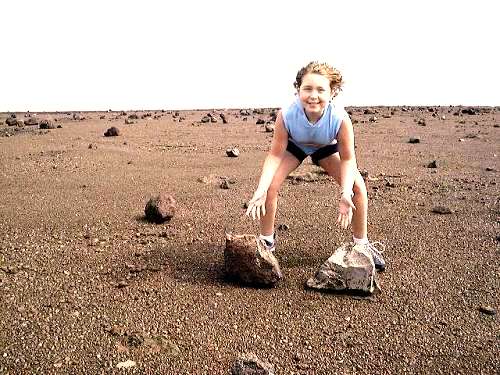
March, 2001

Lab Photo Homepage
Martian Analogs
Scenes from a bad SciFi movie?


The observed similarities between the ancient Martian environment and certain current environments on Earth is leading exobiologists to study terrestrial structures, Antarctic lakes, and remote areas as possible analogs to those purported to have existed on an early Mars.
Earth is our "baseline" for understanding the geologic processes of other worlds. We see something similar and look to Earth to create a possible model. But it is easy to be misled. Environments may or may not be similar. The above photo, for example, resembles images returned by the Pathfinder mission. However, it is a photograph taken on the southwest section of the Kilauea caldera in Hawaii.
Volcanic blocks strewn across the ash field resemble the rock-strewn Martian surface. Although similar in appearance, to conclude that both are the result of a similar geologic process would be incorrect. Volcanic steam explosions propelled the pieces of basalt (blocks) in the above image while, the boulder-strewn area on Mars, is believed to be of a water origin - catastrophic flooding.

Mars panorama- the "Rock Garden"
Devon Island
Many of the surface features on Mars are attributed to periglacial (ice, snow) and possibly, fluvial (valley-forming) processes. One terrestrial environment that may be an analog is the Houghton crater at Devon Island located high in the Canadian Arctic. Houghton crater, the result of an impact 21 million years ago, is huge - 20.5km in diameter. The crater lies near the northern shore of the island where the geologic province is the Arctic Platform made up of marine sedimentary rocks. The eastern end of the island has exposures of the older Canadian Shield metamorphic rocks.
The impact penetrated into these sedimentary beds, creating an impact brecciation that reached depths of 1700 meters. The impact breccia at Houghton is permeated with ground-ice and currently weathering in a relatively arid periglacial environment. In this sense, the breccia is an analog to what the Martian regolith is presumed to be.
An ongoing investigation of the periglacial formations at the Houghton impact structure seems to indicate a similarity of process and is proving helpful in understanding the evolution, distribution, and occurrence of Martian ground-ice. It is easy to argue that if life ( or evidence for relic life) is to be found on Mars, it would very likely be in the depths of this breccia.

Lichen covered rock, Devon Island
The fluvial processes (water drainage, method of erosion) at Devon may also help to understand similar valley structures observed on Mars. This link is less clear though and much research needs to be done to resolve the unknown origin and evolution of the Martian Valley Networks.

Devon Island. Understanding the nature of the drainage at and around Houghton, which resembles some Martian valleys, may help to identify any fluvial processes that have operated on Mars.
 |
 |
"Yogi", Martian surface |
Volcanic basalt, Kilauea, Hawaii. Note the similarity in the scalloping of the soil beneath both rocks from wind erosion. |

Volcanic basalts strewn across the Kilauea ash field

Impact breccia outcropping, Houghton crater.
Additional information at:
This document maintained by
staff@meteorlab.com.
Material
Copyright © 2001 New England Meteoritical Services. Index